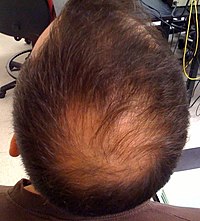
Photo from wikipedia
Male pattern hair loss (MPHL), also referred to as male androgenetic alopecia (AGA) is the most common type of non-scarring progressive hair loss, with 80% of men suffering from this… Click to show full abstract
Male pattern hair loss (MPHL), also referred to as male androgenetic alopecia (AGA) is the most common type of non-scarring progressive hair loss, with 80% of men suffering from this condition in their lifetime. In MPHL, the hair line recedes to a specific part of the scalp which cannot be accurately predicted. Hair is lost from the front, vertex, and the crown, yet temporal and occipital follicles remain. The visual effect of hair loss is due to hair follicle miniaturisation, where terminal hair follicles become dimensionally smaller. Miniaturisation is also characterised by a shortening of the growth phase of the hair cycle (anagen), and a prolongation of the dormant phase (kenogen). Together, these changes result in the production of thinner and shorter hair fibres, referred to as miniaturised or vellus hairs. It remains unclear why miniaturisation occurs in this specific pattern, with frontal follicles being susceptible while occipital follicles remain in a terminal state. One main factor we believe to be at play, which will be discussed in this viewpoint, is the developmental origin of the skin and hair follicle dermis on different regions of the scalp.
Journal Title: Experimental dermatology
Year Published: 2023
Link to full text (if available)
Share on Social Media: Sign Up to like & get
recommendations!